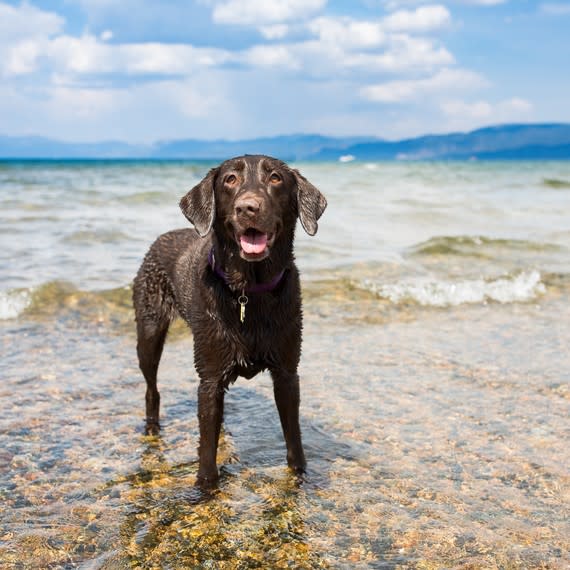How to Prevent and Treat a Pet's Sunburn

Summer sun means plenty of outdoor time for our pets. The longer daylight hours give you and your pet more opportunities for getting outside and enjoying nature. But, like humans, animals can (and do) get sunburned. "Most animals are naturally protected from the sun by either fur or pigmented skin," explains Erin Katribe, DVM, MS, medical director at the Best Friends Animal Society. "Without these protections, though, pets can be susceptible to sunburn." Animals that have light-colored fur, minimal fur or no fur at all risk sunburn when they spend too much time in the sun. Pets that also have unpigmented skin (white or pink) or shaved areas can also get sunburnt.
Like in humans, overexposure to the sun can lead to sunburn and skin cancer in our pets. We can protect our animals from sun-related skin problems by following a few simple steps that reduces their exposure and keeps them safe. Here, two veterinarians share some of their advice on preventing and treating a pet's sunburn.
RELATED: How to Keep Your Pets Safe During a Heatwave
Avoid direct sunlight.
Many of the same rules for sun prevention and treatment that we humans have to follow applies to our pets. Shade is your friend. Stay out of direct sunlight as much as possible. Hyunmin Kim, DVM, veterinary staff manager, community medicine for the ASPCA, advises avoiding the sun at its highest temperature points during the day. "Sunburn in pets occurs when they are overexposed to the ultraviolet rays from the sun," says Kim. "Sunburns can be different in each pet depending on their coloring and how often they are exposed to the sun."
Add protective clothing.
Those little doggie outfits are more than just for looks. Sure, your pup looks adorable in a dress or shirt, but the clothing can give your pet some extra protection against the sun's dangerous rays. "Sun shirts are also available to put on your pet to protect their skin," Kim says. "Dogs that spend a lot of time outdoors can also benefit from goggles, which can protect their eyes from UV exposure." The clothing, especially those designed for sun protection, blocks the worst of the UV rays from touching your pet's skin and is one defense against sunburn.
Apply special sunscreen to exposed areas.
You can apply special sunscreen to your pet's exposed skin, but both veterinarians caution against using the sunscreen that you use on yourself. "Some sunscreens designed for human use have ingredients that are toxic to animals, such as zinc," Katribe says. "So, make sure the product is safe for pets." You can ask your vet for sunscreen that is designed for animals and follow all of the application instructions. Your pet may also try to lick off the sunscreen. Ask your vet how you reduce or keep your pet from licking it off. Remember: Only use sunscreen that is made for pets; never apply sunscreen that is meant for us humans.
Hydrate, hydrate, hydrate.
If you can't avoid spending a significant amount of time outdoors, make sure to keep your pet well-hydrated. Bring along fresh, chilled water for your pet in a collapsible bowl. Hydration will keep your pet from being overheated. Because sunburn can also contribute to dehydration, Kim says, it is extremely important to keep your pet hydrated when spending time outdoors in the sun. Drinking enough water won't necessarily prevent sunburn, but it can reduce other complications of sun exposure, like heat-related illnesses.
Don't shave your pet.
You may think that shaving all the hair off your pet will keep him or her cooler in the summer, but it actually removes some of their natural sun protection. "Pet owners should not shave their dogs in the summer as their fur provides a barrier to sunburn," explains Kim. "A trim in the summer is fine, but they should not be shaved down to their skin." Remember that the more exposed skin your animal has, the greater risk for sunburn. Keep your pet safely groomed by maintaining their fur covering all year long.
Limit window-watching.
Does your indoor cat enjoy a window perch? She may be susceptible to sunburn if she is hairless or has light-colored fur. "The tips of the ears, nose, and paws are most commonly affected as those areas have the thinnest fur coverage," says Kim. "Ultraviolet light can pass through glass, so owners with hairless cats or those with light-colored fur should prevent them from spending too much time in the sun by closing drapes and blinds." You can also look into window treatments that reduce UV exposure but still allow your pets to watch birds and other wildlife through the window. UV-blocking window film is easy to apply and friendly to most budgets.
Know the signs of sunburn and treat accordingly.
Despite our best efforts, a sunburn can happen. How do you identify one on your pet? "Sunburn in animals can present as redness, flaking or warm skin, and may be painful for your pet," says Katribe. Mild cases of sunburn can be treated with cold compresses and prescribed ointments from your veterinarian. Severe cases should always involve a visit to the vet because inflammation and secondary infections are possible. When in doubt, visit your veterinarian. You want to be mindful of the time that you and your pet are spending in the sun, and get out of harm's way before a sunburn even happens.
(function(d, s, id) { if (d.getElementById(id)) return; var js = d.createElement(s); js.id = id; js.src = '//cdn4.wibbitz.com/static.js'; d.getElementsByTagName('body')[0].appendChild(js); }(document, 'script', 'wibbitz-static-embed'));
